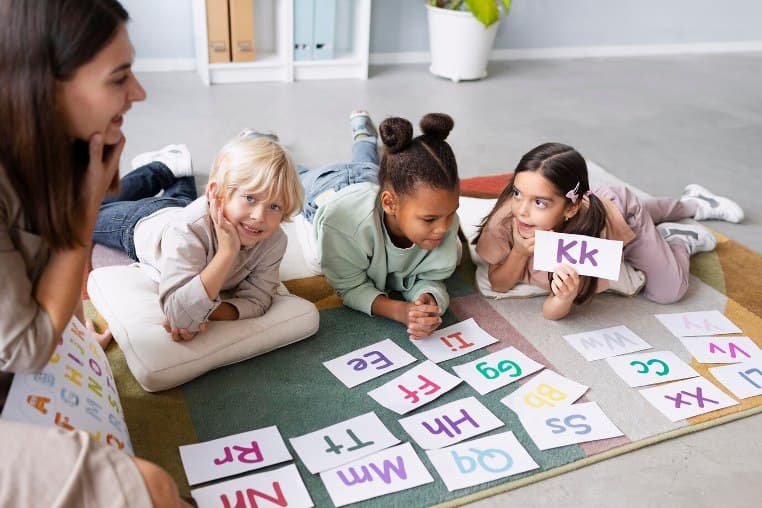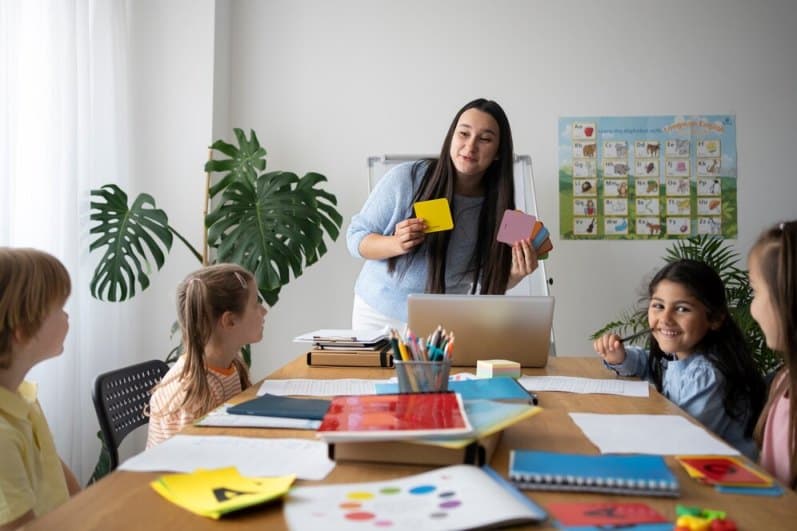Some adults think that circle time at preschools, daycares, and kindergartens is just an excuse to waste time. However, it’s actually quite the opposite. Circle time has been shown to have significant benefits for preschoolers’ social, emotional, and mental development. Circle time also allows adults to build strong relationships with kids so they can foster their development.
What is circle time?
Circle time is a block of time during class in which students gather in a circle to talk about a topic, learn new skills and have fun.
Teachers can tailor the circle time experience for their students by including games and songs, structured debates, or focusing on particular subjects such as math or science.
Reasons why circle time is essential for preschoolers
To make the learning process interesting and grow teamwork tendencies in students, circle time plays a significant role. There are some more reasons that make this activity essential. Let’s have a look at these reasons.
1. Improves teamwork and social skills
Working with others, in front of the class, or at their own pace will help children develop social skills that will come in handy later on in life. Circle time promotes social skills through interactions with classmates and exposure to varied activities.
Kids learn to work collaboratively with peers, share, and be good friends. Also, there is a real sense of shared responsibility and teamwork in circle time, where every child has an important role to play, regardless of their individual skills or personalities.
2. Encourages listening skills
Circle time is an effective way to ensure that kids are active listeners. Kids have to listen to their peers as everybody takes their turn.
When a child can hear other children’s voices and ideas, they are much more likely to be willing to give up their turn when asked or stop talking for someone else to get a chance.
Also, it increases the attention span, allowing kids to stay focused during lessons. And when kids listen and pay attention, they also become better at understanding instructions.
3. Creates a non-judgmental environment
We are quick to judge people, but it’s equally important to be mindful of how we react to those who might not think like us. Circle time creates a space where all opinions and perspectives are valued, even if they don’t align with your own.
As preschoolers develop their understanding of the world, they must have a safe space to share their feelings and learn that others may experience the same feelings without any threat or judgment. With circle time, children know that everyone will listen to them and respect what they say.
4. Fosters creativity and problem solving
Kids learn best when they talk, work and play with each other. When a child comes up with an idea or problem during circle time that others can’t solve, he or she can then work on the issue for a time until an answer is reached.
This fosters a sense of teamwork as well as creativity and problem-solving skills.
5. Strengthens communication skills
It fosters communication skills between students and teachers. Circle time helps children develop communication skills by reinforcing the importance of eye contact, listening, understanding, and getting the other person’s perspective.
At its most basic, circle time is also a way for children to practice their oral language skills. These skills help children develop the ability to speak clearly and correctly.
6. Teaches routines and sequences
Circle time teaches routines and sequences of actions. It can be an excellent way to practice skills such as turn-taking.
For example, it encourages children to speak only when it is their turn, participate enthusiastically when it is their turn, and also wait patiently until it is their turn again.
7. Builds self-confidence and self-esteem
Circle time is a great way to allow preschoolers an opportunity to participate. Participation builds self-confidence and self-esteem in children. It teaches them to speak with conviction: In circle time, kids are expected to say something, which makes them more inclined to speak up in class.
When they feel they are important and able to contribute, they feel better about themselves and what they have accomplished. These positive feelings can spill over into other aspects of their lives outside of the circle time activity. They will be more likely to want to work on challenging tasks that require participation rather than avoiding them.
8. Provides a sense of belonging
Kids tend to get shy, but as they’re forced to participate in group activities, they’re less likely to feel like outsiders. Knowing that their classmates are looking out for them creates a feeling of mutual acceptance and community.
Additionally, they learn what it means to be part of a team and work together as a unit. This helps build self-esteem as they see others responding positively to their own contributions.
9. Helps manage emotions
In addition to providing supportive relationships for kids, circle time also helps them learn how to manage their emotions effectively.
Kids don’t always know what to do when they feel frustrated, angry, or sad. So they often take those feelings out on others in destructive ways. Through circle time, children get lots of practice identifying their feelings and appropriately expressing them through games and songs.
10. Balances work and play
Young learners need to learn to work hard and play hard, but sometimes children focus too much on one or the other. With long days at school that include many hours of instruction, students may start viewing breaks as pure relaxation rather than opportunities for growth.
During circle time, they’ll find a balance between both. Not only does the break offer some physical rest, but it also helps give their brains a chance to recharge and process new information.
How to realize circle time benefits
Although circle time can be very beneficial, whether you are actually getting those benefits depends greatly on the teacher and the institution.
The research paper on How Do Preschool Classrooms Use This Part of the Day clearly shows the evidence of squandering valuable learning time in preschoolers and how it can be improved.
Try the following recommendation to get the best preschool in close vicinity:
- Talk to people with experience and the intent to help you
- Visit the school
- Obtain the school’s schedule
- Talk to the teachers
- Try to mingle with the school staff
- Observe the school environment
- Check for safety protocols
I know these seem hard and time-consuming. But you have to do it for the kid.
Conclusion
I hope this post has helped inform you about the benefits of circle time for preschool children. Whether a preschool teacher or parent, it is important to ensure your kids have as much physical activity in their day as possible, which is where circle time can help.
ac
These are just a few of the many benefits circle time offers. They will be learning, socializing, and moving around in a different way than they would at a desk.





